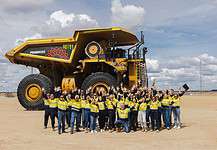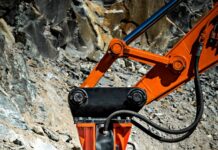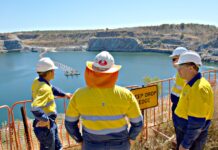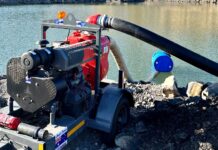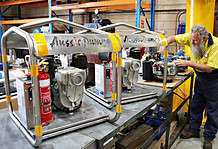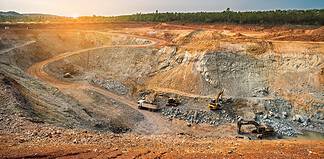When it comes to the efficient use of valuable water resource, dust suppression is often a significant factor in an operation’s overall useage of this precious and expensive resource.
Australian-headquartered Marc Technologies is a noted specialist in the area and it is able to offer a number of options that not only help keep the dust under control – but can also save clients money and water.
“There is a suite of different techniques that we use for dust depression. We utilise specialist technologies that are very, very efficient in terms of water usage and also very effective in terms of dust control,” Marc Technologies Air Division Manager, Dave McMillan, told the AMR recently.
The two main water efficient, dust suppression systems that Marc Technologies may utilise to solve a client’s dust issues are the Dust Solutions Inc. (DSI) “Dry Fogging” systems and the DSI NESCO High Pressure Misting Systems. Marc is the Australian distributor for the DSI “Dry Fogging” systems.
These systems produce ultra-fine water droplets of 100% sub-10 microns, which make them very efficient. “DSI’s Dry Fogging systems have been trialled and accepted by some of the largest miners in the world and have been proven extremely effective.
The systems generate a fog with low pressure water and air and so are an efficient, low cost method of controlling fugitive dust from crushing, screening, conveying, loading, and unloading activities in almost any bulk material handling application,” Dave said.
Fog dust control systems are as efficient as dust extraction systems with fabric filters or wet scrubbers but require only a fraction of the operating horsepower and maintenance costs.
Dust is controlled at the source and settles back onto the conveyor or stockpile. With dust extraction systems the dust that is extracted needs to be disposed of – which leads to further handling and more dust sources.
MARC’s Fog dust control systems have a number of benefits, including:
- Simple to install and operate.
- Modular Design – unique block design allows multiple treatment points from a single cabinet, with standard modules with minimal maintenance requirements in a cost-effective package.
- Require no secondary dust or sludge handling systems that are typically required for Dust Collector Systems.
- Automated and self-cleaning, with minimal maintenance, nozzle wear or blockages.
DSI’s Dry Fogging systems have dual water filtration systems as standard, including automated backwashing, stainless steel nozzles that don’t wear out and actually vibrate in use, meaning there is no material build-up that can cause a blockage.
“The systems are automated and controlled through a PLC to ensure constant performance. We can also provide manual systems at a lower cost option,” Dave said.
The principal of operation is based on the probability of like-sized water and dust particles colliding, agglomerating, and growing in size and mass. As the agglomerates become larger and heavier they settle back onto their source where they are carried through the process without any special handling. When the particles are significantly different in size, the larger particle displaces enough air to carry the smaller particle around it without Fogging a Primary Crusher.
For this reason, most water sprays are ineffective against airborne dust as the droplets are too big to combine with the dust particles.
“We use them in ROMs bins, we have installed them in ship loaders, reclaimers and conveyor transfers, basically all over the plant, wherever there is material handling.
“They are extremely water efficient and we may only utilise around five litres per minute for a typical nozzle and at maximum at about maybe 50 litres per minute for a large ROM bin.
“You compare that to traditional water sprays where you are talking several times that, and you can see our Dry Fog systems are a very efficient system in terms of water usage. And that’s obviously critically important, especially with the cost and scarcity of water resource in Australia.”
The second weapon in MARC Technologies’ armoury is DSI’s NESCO high pressure misting system.
The NESCO DustPro High Pressure Spray Systems control dust by producing a highly atomised mist where needed, that suppresses airborne particulates at the source of generation, as well as treatment points for conditioning that target from 0.2% to 0.5% moisture by weight to the process to prevent visible dust emissions from downstream operations.
The system produces water particles fine enough to effectively knock down visible dust, but also force the controlled amount of water into the product.
Controlled moisture addition is key in areas such as truck dumps, crushing and transfer points and also minimises dust issues within downstream processes. These systems can be supplied as a standalone system to tackle a single problem area, or as a cost-effective entire plant system that takes into account the various processes and treats accordingly to eliminate the dust issue.
“We are very careful about how we add the moisture and how we use it in specific areas. We use medium pressure, about 15 bar, to achieve good penetration into the material as well and the effect that that has, as opposed to low pressure deluge type systems, is that we get moisture where it’s needed into the material not just sitting on top of the material.
“We concentrate on getting the moisture into key areas such as the crusher and that means that further down the process there is not significant dust lift-off from areas such as screens, downstream crushers and stackers, which means we obtain excellent dust control results with less water. That is very relevant to what we’re trying to do here.” Dave says that dust control is an issue of growing importance in Australia.
“There is a big push for dust control because of the concerns around silica dust and other potential hazardous airborne substances. “There has been a tightening of regulations and there is a big push for dust control to be a bit more to the fore in mine planning and daily operations.
“The other side of the issue is the scarcity of water. The cost of water is always going to come into play, particularly in remote locations. This means that companies and the community are looking more closely at water efficient systems.”
Marc Technologies has supplied many Dry Fogging and NESCO systems across Australia to date, with a number of orders currently on the books.
“The NESCO system, in particular, has only been available in Australia for the last two and a half years to three years, but we have already sold a number of them and we have received a lot more inquiries. They have earned a very good reputation and are well established in the Americas, with well over 1000 installations”
While the “Dry Fogging” and NESCO systems are basically static systems, Dave revealed that Marc Technologies also offers containerised systems that are suitable for mobile and semi-mobile crushnig plants – which will provide a mobile option.
Another of Marc Technologies dust suppression options that is proving to be particularly popular, especially in Western Australia’s Pilbara region, are the DustTamer Windfences. While they can be used for a variety of applications, they are most often used to lower wind velocities downwind of a screen’s location. Reducing wind speeds reduces the amount of airborne dust that is liberated due to wind effect around material handling operations such as stockpiles, stack-out conveyors, truck, rail or loader dump pockets, conveyor lines and load out silos.
“The traditional way of trying to prevent dust lift off from stockpiles is to run water sprays. Obviously stockpiles are fairly sizable and when the stockpiles are dry or drying out fairly quickly, you basically need a lot of water to control dust migration.
“Which is a huge waste of water as the pile willl dry out and require constant re-wetting, so it is a significant cost over time. A DustTamer windfence is a permanent structure, and the material we guarantee for 20 years without need for replacement, so the ROI is there for the life of the mine.” Dave says the wind fences are very effective at reducing the wind effect and stopping the lift off of the fines from the stockpile itself.
The systems are gaining in popularity and there are many installations worldwide, with some of the biggest names in mining have already introduced them for their projects. The DSI DustTamer is often used in conjunction with DSI Dry Fog systems to facilitate the agglomeration and settling of dust in ROM bins and transfer towers.
The windfence enhances the Dry Fog system performance as it helps prevent wind effect on the fog and dust and allows the fog do it’s job effectively.
DustTamer can also control the dust lift off from Mine Tailing’s Ponds. Both permanent fences and portable screens can be used to decrease particle take-up. Compututational Fluid Dynamics (CFD) modelling, another service offered by MARC to simulate the windfence in a 3D model to optimise the fence and prove it’s effectiveness, also proved the system’s effectiveness as opposed to a solid wall.
This is as a result of the fabric’s specially designed porosity. The fence allows a ‘bleed through’ of air that helps to equalise wind pressure on either side of the fence and introduces a drag force that reduces overall wind velocity to below the threshold for take-up of particles from a stockpile, for example.
Solid, non-porous “dust covers” or “wind walls” can actually worsen the problem by creating a low pressure zone at the dust source. Air will move from a high to low pressure area, increasing velocities and airborne particulate. If you have a dust suppression issue, then Marc Technologies has you covered.




